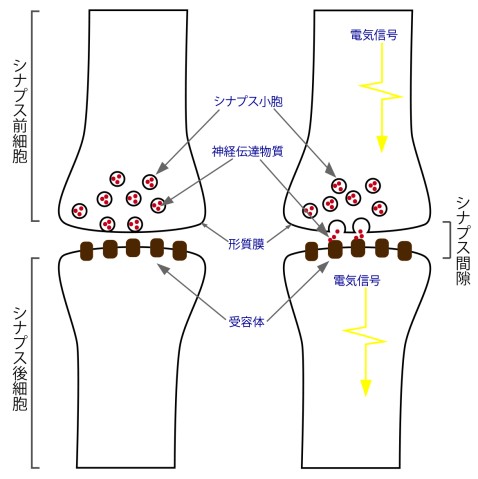Synaptic transmission

On the left, a neuronal synapse at rest: synaptic vesicles are ready to release chemical messengers called neurotransmitters. On the right: An electrical signal arrives at a terminal of one neuron and then triggers synaptic vesicles release by fusion with the plasma membrane. The neurotransmitters contained within the vesicles are “spilled” in the synaptic gap (known as synaptic cleft) between the two neuronal cells. The neurotransmitters then activate receptors on the second neuron, which in turn trigger an electrical signal that is transmitted along the second neuron. The empty vesicles return to their original nerve terminal and are refilled with neurotransmitter to be reused for another round of synaptic transmission. The inside of the pre-synaptic terminal is tightly packed with thousands of proteins which control this complex process of vesicle release and recovery. The recovery and reuse of vesicles are very important parts of the maintenance of synaptic function because without it, the synapse becomes depleted and stops functioning.
On the left, a neuronal synapse at rest: synaptic vesicles are ready to release chemical messengers called neurotransmitters. On the right: An electrical signal arrives at a terminal of one neuron and then triggers synaptic vesicles release by fusion with the plasma membrane. The neurotransmitters contained within the vesicles are “spilled” in the synaptic gap (known as synaptic cleft) between the two neuronal cells. The neurotransmitters then activate receptors on the second neuron, which in turn trigger an electrical signal that is transmitted along the second neuron. The empty vesicles return to their original nerve terminal and are refilled with neurotransmitter to be reused for another round of synaptic transmission. The inside of the pre-synaptic terminal is tightly packed with thousands of proteins which control this complex process of vesicle release and recovery. The recovery and reuse of vesicles are very important parts of the maintenance of synaptic function because without it, the synapse becomes depleted and stops functioning.
Copyright OIST (Okinawa Institute of Science and Technology Graduate University, 沖縄科学技術大学院大学). Creative Commons Attribution 4.0 International License (CC BY 4.0).
Tags














